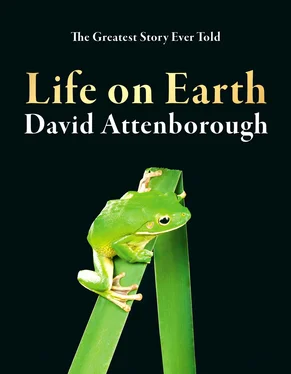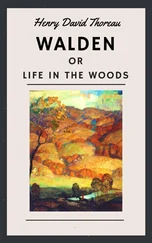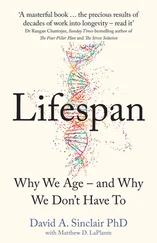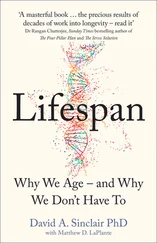A mule will carry you in an easy day’s ride from the rim to the very bottom of the Canyon. The first rocks you pass are already some 200 million years old. There are no remains of mammals or birds in them, but there are traces of reptiles. Close by the side of the trail, you can see a line of tracks crossing the face of a sandstone boulder. They were made by a small four-footed creature, almost certainly a lizard-like reptile, running across a beach. Other rocks, at the same level elsewhere, contain impressions of fern leaves and the wings of insects.
Halfway down the Canyon, you come to 400-million-year-old limestones. There are no signs of reptiles to be found here, but there are the bones of strange armoured fish. An hour or so later – and a hundred million years earlier – the rocks contain no sign of backboned animals of any kind. There are a few shells and worms that have left behind a tracery of trails in what was the muddy seafloor. Three-quarters of the way down, you are still descending through layers of limestone, but now there is no sign of fossilised life whatever. By the late afternoon, you ride at last into the lower gorge where the Colorado River runs green between high rock walls. You are now well over a vertical kilometre below the rim, and the surrounding rocks have been dated to the immense age of 2,000 million years. Here you might hope to find evidence for the very beginnings of life. But there are no organic remains of any kind. The dark fine-grained rocks lie not in horizontal layers like all those above, but are twisted and buckled and riven with veins of pink granite.
Are signs of life absent because these rocks and the limestones directly above are so extremely ancient that all such traces have been crushed from them? Could it be that the first creatures to leave any sign of their existence were as complex as worms and molluscs? For many years these questions puzzled geologists. All over the world, rocks of this antiquity were carefully searched for organic remains. One or two odd shapes were found, but most authorities dismissed these as patterns produced by the physical processes of rock formation that had nothing whatever to do with living organisms. Then during the 1950s, the searchers began to use high-powered microscopes on some particularly enigmatic rocks.
Around 1,600 kilometres northeast of the Grand Canyon, ancient rocks of about the same age as those beside the Colorado River outcrop on the shores of Lake Superior. Some of them contain seams of a fine-grained flint-like substance called chert. This was well known during the nineteenth century because the pioneers used it in their flintlock guns. Here and there, it contains strange white concentric rings a metre or so across. Were these merely eddies in the mud on the bottom of the primeval seas, or could they have been formed by living organisms? No one could be sure and the shapes were given the noncommittal name of stromatolite, a word derived from Greek meaning no more than ‘stony carpet’. But when researchers cut sections of these rings, ground them down into slices so thin that they were translucent and examined them through the microscope, they found, preserved in the chert, the shapes of simple organisms, each no more than one or two hundredths of a millimetre across. Some resembled filaments of algae; others, while they were unmistakably organic, had no parallels with living organisms; and some looked to be identical with the simplest form of life existing today: bacteria.
It seemed almost impossible to many people that such tiny things as microorganisms could have been fossilised at all. That relics of them should have survived for such a vast period of time seemed even more difficult to believe. The solution of silica which had saturated the dead organisms and solidified into chert was clearly as fine-grained and durable a preservative as exists. The discovery of the fossils in the Gunflint Chert stimulated further searches not only in North America but all over the world, and other microfossils were found in cherts in Africa and Australia. Some of these, astonishingly, pre-dated the Gunflint specimens by a billion years, and some scientists now claim to have found fossils from around 4 billion years ago, not long after the formation of the earth. But if we want to consider how life arose, fossils cannot help us, for the origin of life involved the interaction of molecules, which leave no fossil traces. To understand what scientists think happened we have to look back beyond even the earliest microfossils, to a time when the earth was completely lifeless.
In many ways the planet then was radically different from the one we live on today. There were seas, but the way the land masses lay bore no resemblance in either form or distribution to modern continents. Volcanoes were abundant, spewing noxious gases, ash and lava. The atmosphere consisted of swirling clouds of hydrogen, carbon monoxide, ammonia and methane. There was little or no oxygen. This unbreathable mixture allowed ultraviolet rays from the sun to bathe the earth’s surface with an intensity that would be lethal to modern animal life. Electrical storms raged in the clouds, bombarding the land and the sea with lightning.
Laboratory experiments were made in the 1950s to discover what might happen to these particular chemical constituents under such conditions. Such gases, mixed with water vapour, were subjected to electrical discharge and ultraviolet light. After only a week of this treatment complex molecules were found to have formed in the mixture, including sugars, nucleic acids and amino acids, the building blocks of proteins. We now know that such simple organic molecules can be found throughout the universe, including on interstellar bodies such as comets. But amino acids are not life, nor are they even necessary for life to exist. The experiment proved little about the origin of life.
All forms of life that exist today share a common way of transmitting genetic information, of telling cells what to do. It is a molecule called deoxyribonucleic acid, or DNA for short. Its structure gives it two key properties. First, it can act as a blueprint for the manufacture of amino acids; and second, it has the ability to replicate itself. With this substance, molecules had reached the threshold of something quite new. These two characteristics of DNA also characterise even the simplest of living organisms such as bacteria. And bacteria, besides being the simplest form of life we know, are also among the oldest fossils we have discovered.
The ability of DNA to replicate itself is a consequence of its unique structure. It is shaped like two intertwined helices. During cell division, these unzip, splitting the molecule along its length into two separate helices. Each then acts as a template to which other simpler molecules become attached until each has once more become a double helix.
The simple molecules from which the DNA is mainly built are of only four kinds, but they are grouped in trios and arranged in a particular and significant order on the immensely long DNA molecule. This order specifies how the twenty or so different amino acids are arranged in a protein, how much is to be made, in what tissue and when. A length of DNA bearing such information for a protein, or for how a protein should be expressed, is called a gene.
Occasionally, the DNA copying process involved in reproduction may go wrong. A mistake may be made at a single point, or a length of DNA may become temporarily dislocated and be reinserted in the wrong place. The copy is then imperfect and the proteins it will create may be entirely different. Changes in the DNA sequence can also be induced by chemicals or radiation. When this occurred in the first organisms on earth, evolution began, for such hereditary changes, brought about by mutation and errors, are the source of variations from which natural selection can produce evolutionary change.
Читать дальше












